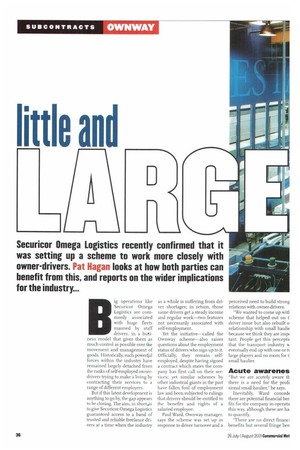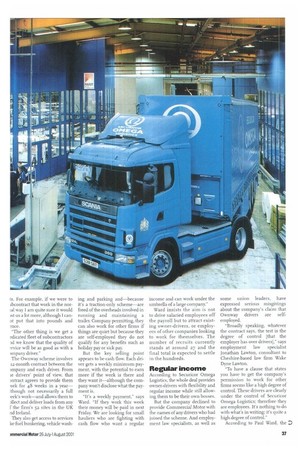lilt
Page 36

Page 37

Page 38

If you've noticed an error in this article please click here to report it so we can fix it.
le and
Securicor Omega Logistics recently confirmed that it was setting up a scheme to work more closely with
owner-drivers. Pat Hagan looks at how both parties can
benefit from this, and reports on the wider implications for the industry...
ig operations like Securicor Omega Logistics are commonly associated with huge fleets manned by staff drivers, in a business model that gives them as much control as possible over the movement and management of goods. Historically, such powertid forces within the industry have remained largely detached from the ranks of self-employed ownerdrivers trying to make a living by contracting their services to a range of different employers.
But if this latest development is anything to go by, the gap appears to be closing. The aim, in short,.is to give Securicor Omega Logistics guaranteed access to a band of trusted and reliable freelance drivers at a time when the industry as a whole is suffering from driver shortages; in return, those same drivers get a steady income and regular work—two features not necessarily associated with self-employment.
Yet the initiative—called the Ownway scheme—also raises questions about the employment status of drivers who sign up to it. Officially, they remain selfemployed, despite having signed a contract which states the company has first call on their services; yet similar schemes by other industrial giants in the past have fallen foul of employment law and been subjected to rulings that drivers should be entitled to the benefits and rights of a salaried employee.
Paul Ward, Ownway manager, says the scheme was set up in response to driver turnover and a perceived need to build strong relations with owner-drivers.
"We wanted to come up witl scheme that helped out on f driver issue but also rebuilt o relationship with small haulic because we think they are imp( tant. People get this percepti( that the transport industry w eventually end up with one or tN large players and no room for t] small haulier.
Acute awarenes
"But we are acutely aware th there is a need for the prof( sional small haulier," he says.
Inevitably, Ward concedt there are potential financial ber fits for the company in operatii this way, although these are ha to quantify.
"There are no direct financi benefits but several fringe ben
ts. For example, if we were to ibcontract that work in the nortal way 1 am quite sure it would )st us a lot more, although I canot put that into pounds and ence.
"The other thing is we get a edicated fleet of subcontractors 1c1 we know that the quality of ervice will be as good as with a )mpany driven"
The Ownway scheme involves 12-month contract between the )mpany and each driver. From ie drivers' point of view, that antract agrees to provide them rork for 48 weeks in a year-though not necessarily a full rek's work—and allows them to 311ect and deliver loads from any U the firm's 52 sites in the UK rid Ireland.
They also get access to services ke fuel bunkering, vehicle wash ing and parking and—because it's a traction-only scheme—are freed of the overheads involved in running and maintaining a trailer. Company permitting, they can also work for other firms if things are quiet but because they are self-employed they do not qualify for any benefits such as holiday pay or sick pay.
But the key selling point appears to be cash flow. Each driver gets a weekly minimum payment, with the potential to earn more if the work is there and they want it—although the company won't disclose what the payment is.
"It's a weekly payment," says Ward. "If they work this week their money will be paid in next Friday. We are looking for small hauliers who are fighting with cash flow who want a regular income and can work under the umbrella of a large company."
Ward insists the aim is not to drive salaried employees off the payroll but to attract existing owner-drivers, or employees of other companies looking to work for themselves. The number of recruits currently stands at around 27 and the final total is expected to settle in the hundreds.
Regular income
According to Securicor Omega Logistics, the whole deal provides owner-drivers with flexibility and regular income while still allowing them to be their own bosses.
But the company declined to provide Commercial Motor with the names of any drivers who had joined the scheme. And employment law specialists, as well as
some union leaders, have expressed serious misgivings about the company's claim that Ownway drivers are selfemployed.
"Broadly speaking, whatever the contract says, the test is the degree of control [that the employer has over drivers]," says employment law specialist Jonathan Lawton, consultant to Cheshire-based law firm Wake Dyne Lawton.
"To have a clause that states you have to get the company's permission to work for other firms seems like a high degree of control. These drivers are clearly under the control of Securicor Omega Logistics; therefore they are employees. It's nothing to do with what's in writing; it's quite a high degree of control."
According to Paul Ward, the company is happy to release contraded drivers to work elsewhere providing it is in a position to do so.
"The contract states that we have first call on them but there is flexibility. If a driver said on a Wednesday he had been offered some work for the following week and we were in a position to release him we would. Then he would come back as and when it was over."
Working Time
There is also speculation that the scheme may help the company get round the restrictions imposed by the Working Time Directive. Under current plans, self-employed drivers are exempt from the directive, and although it seems certain they will eventually be included, this is unlikely to happen for several years.
Ward concedes that the directive was a factor in the company's decision to set up Ownway, but not the reason behind it—especially as the company has no plans to scale down its driver workforce. And he is adamant that Ownway drivers are not classed as employees.
"I'd be lying if I said it was not a consideration but it's not the reason for launching the scheme," he says. "These drivers are not in liveried vehicles and they are responsible for their own VAT The only tie (between us) is the work that we give them."
But United Road Transport Union general secretary Bob Monks says the scheme raises serious issues.
"I think Securicor Omega Logistics is sailing pretty close to the wind on the question of whether they are employees. It's to do with the amount of control that takes place and it seems it's not the absolute right of these people to accept other work.
"It may be that the company is thinking about the Working Time Directive, especially if it has employees who come under the directive and are having to drive fewer hours when owner-drivers are excluded."
Monks believes that while the company may not reduce the numbers of staff drivers, it may use owner-drivers to fill any gaps that emerge during expansion in the coming years.
The true test of this unlikely marriage of convenience will be whether drivers are happy in the long run with the terms and conditions on offer.




















































































































